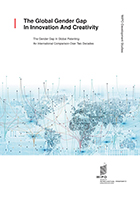Innovation Gender Gap: Austria’s Efforts to Empower Women in Innovation and Patenting
May 22, 2024
By: Sergio Martinez-Cotto and Renate Spring
Engaging women in science, technology and innovation is crucial for societies to address pressing social and economic issues. Drawing from Austria’s recent ranking in female inventor rates across Europe, the Austrian Patent Office conducted a qualitative study to identify and ramp up pivotal initiatives for empowering women in innovation and patenting. Let’s take a look at these initiatives!

Reasons for low rates of female inventors
The low rate of female inventors in Austria is a multifaceted issue with roots in various societal and systemic factors. The Austrian Patent Office surveyed the main actors of their innovation ecosystem (entrepreneurs, inventors, researchers, etc.) and categorized their responses into 7 main groups. Their findings pointed out that 73% of these reasons are related to labor market dynamics and societal norms.
In response, Austria is taking action by implementing targeted initiatives to overcome these barriers and promote greater participation of women in innovation.
Initiatives that support women inventors in Austria
-
"Buddy for Her" Mentoring Program
Austria's Patent Office has taken a proactive stance with the launch of the "Buddy for Her" mentoring and counseling program. This initiative pairs female patent examiners and inhouse trademark lawyers with aspiring women inventors and creators of IP, providing them with direct advice and guidance. The focus on accessibility ensures that women feel supported and empowered as they navigate the intricacies of intellectual property processes. By promoting female mentors and role models, the Patent Office aims to eliminate existing inhibitions and to promote female ingenuity with inhouse expertise in all stages of the innovation process. Additionally, the Austrian Patent Office offers free of charge patent searches for promising projects presented to female buddies participating in the program. This way, customers can make informed decisions on their next steps.
-
Awareness Raising Platforms for Intellectual Property Rights
The second set of initiatives focus on raising awareness for intellectual property rights among women. To achieve this, the Patent Office is implementing special training formats and creating networking platforms tailored to the needs of women in innovation. By providing targeted resources and education, the initiative aims to equip women with the knowledge and tools necessary to navigate the complex landscape of intellectual property.
These specialized training programs not only enhance the skills of women inventors but also contribute to building a supportive community. Networking platforms create spaces for collaboration, idea exchange, and mentorship opportunities, fostering an environment where women can thrive in their innovative pursuits.
Additionally, a specifically dedicated podcast installment showcases homegrown female inventors and their remarkable achievements. These podcasts series serve not only as a source of inspiration but also as a powerful tool to raise awareness about the impact of women in inventive activities. Through these initiatives, the Austrian Patent Office is actively working to break down stereotypes and encourage more women to pursue careers in innovation.
-
Incentives to Recognize and Reward Female Inventors
Austria's commitment to promoting gender equality in innovation extends to the introduction of a new category in the Austrian State Award for Patents. Companies with a significant number of female inventors will be eligible for this category, recognizing their contribution to the field. The winning company will collaborate with the IP Academy of the Austrian Patent Office to share insights on IP and gender-related issues with other interested organizations, further amplifying the impact of these initiatives.
Moreover, the Austrian Patent Office is planning to address financial barriers by making the patenting process more affordable for women. Currently, possible implementations for a dedicated financial incentive are explored. The goal of this financial incentive would be to level the playing field and encourage more women to pursue patenting opportunities.
-
Data Transparency Measures
One significant challenge in evaluating the landscape of female inventors in Austria is the absence of mandatory inventor designation in patent applications. To address this, the Austrian Patent Office is considering changes to the Austrian Patent Act to make the designation of inventors mandatory. This action puts the creators of inventions in the spotlight, underscoring the value of inventors, irrespective of their gender, allowing for a more precise evaluation of gender representation in patenting.
Additionally, the introduction of a strategic objective focused on "property rights applications by women" demonstrates a commitment to ongoing progress. By monitoring and reporting on the number of patent applications from women on a yearly basis, the Austrian Patent Office aims to track advancements and identify areas for further improvement.
Related stories

Innovation Gender Gap: What Do We Know About the Gender Gap in Innovation?
In an average high-income country, both women and men may have equal access to early education opportunities that would propel their careers forward. For instance, more women are graduating from bachelor and master programs than men.

Innovation Gender Gap: 5 Initiatives to Narrow the IP Gender Gap in Europe
Considering the growing global recognition of the significance of gender and diversity disparities in innovation, numerous countries have taken steps to address these gaps. A group of delegates from Spain, Poland, the United Kingdom, Lithuania, and Hungary convened to highlight the policies and programs adopted within Europe. Read about them here!
Related resources

The Global Gender Gap in Innovation and Creativity: An International Comparison of the Gender Gap in Global Patenting over Two Decades
This report analyzes women’s participation in international patent applications between 1999 and 2020 and finds that women are involved in only 23% of all applications, representing 13% of all inventors listed. Women’s participation in patenting varies across regions, sectors, and industries, with higher representation in biotechnology, food chemistry, and pharmaceuticals, and lower in mechanical engineering. Women inventors are more prevalent in academia than in the private sector, and typically work in mostly-male teams or alone. Achieving gender parity will require significant effort, with an estimated target year of 2061 based on current trends.
